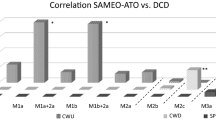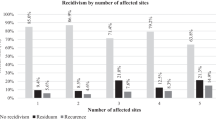Abstract
Objective
To compare the performance of the EAONO/JOS, STAMCO, and ChOLE Cholesteatoma Staging Systems in prognostic evaluation of children acquired middle ear cholesteatoma after primary surgery and identify the other factors that could predict cholesteatoma recidivism. And the correlation between the staging and the recidivism of cholesteatoma after grouping according to operation was evaluated.
Methods
A total of 123 ears of 118 patients that underwent surgery for primary cholesteatoma from November 2008 to May 2020 were included in this retrospective study, and then classified and staged according to the EAONO/JOS, STAMCO, and ChOLE cholesteatoma staging system, respectively. Each indicator involved in the system above was analyzed separately to evaluate its prognostic value for cholesteatoma recidivism.
Results
The type of surgical procedure performed (P = 0.020) was shown to be associated with cholesteatoma recidivism. Cholesteatoma location the supratubal recess (S1) (P = 0.026, HR = 3.614, 95% CI 1.137, 7.945), and the sinus tympani (S2) (P = 0.004, HR = 4.208, 95% CI 1.574, 11.250) were shown to be significantly associated with disease recidivism. When focusing on the CWU operation group, ossicular chain status in STAMCO stage (P = 0.043) and in the ChOLE stage (P = 0.018) were significantly associated with cholesteatoma recidivism. The results had shown no association between the three stages and cholesteatoma recidivism in the CWD and endoscopic surgery groups.
Conclusions
Based on our study, the EAONO/JOS, STAMCO, and ChOLE Classifications have limited value in predicting cholesteatoma recidivism, in acquired middle ear cholesteatoma in children. Adding the pathological status of the ossicular chain may be useful for predicting the recidivism of cholesteatoma. Additional validation studies are entailed to definitively assess the clinical utility of these classifications.

Similar content being viewed by others
References
Kuo CL, Shiao AS, Yung M, Sakagami M, Sudhoff H, Wang CH et al (2015) Updates and knowledge gaps in cholesteatoma research. Biomed Res Int 2015:854024
Nevoux J, Lenoir M, Roger G, Denoyelle F, Ducou Le Pointe H, Garabédian EN (2010) Childhood cholesteatoma. Eur Ann Otorhinolaryngol Head Neck Dis 127(4):143–150
Fontes Lima A, Carvalho Moreira F, Sousa Menezes A, Esteves Costa I, Azevedo C et al (2020) Is pediatric cholesteatoma more aggressive in children than in adults? A comparative study using the EAONO/JOS classification. Int J Pediatr Otorhinolaryngol 138:110170
Rutkowska J, Özgirgin N, Olszewska E (2017) Cholesteatoma definition and classification: a literature review. J Int Adv Otol 13(2):266–271
Yung M, Tono T, Olszewska E, Yamamoto Y, Sudhoff H, Sakagami M, İncesulu A, Trabalzini F, Özgirgin N (2017) EAONO/JOS joint consensus statements on the definitions, classification and staging of middle ear cholesteatoma. J Int Adv Otol 13(1):1–8
Ardıç FN, Mengi E, Tümkaya F, Kara CO, Bir F (2020) Correlation between surgical outcome and stage of acquired middle ear cholesteatoma: revalidation of the EAONO/JOS staging system. J Int Adv Otol 16(1):34–39
Van der Toom H, Van der Schroeff MP, Janssen J, Westzaan AM, Pauw RJ (2020) A retrospective analysis and comparison of the STAM and STAMCO classification and EAONO/JOS cholesteatoma staging system in predicting surgical treatment outcomes of middle ear cholesteatoma. Otol Neurotol 41(4):e468–e474
Bächinger D, Rrahmani A, Weiss NM, Mlynski R, Huber A, Röösli C (2021) Evaluating hearing outcome, recidivism and complications in cholesteatoma surgery using the CHOLE classification system. Eur Arch Otorhinolaryngol 278(5):1365–1371
Merkus P, Ten Tije FA, Stam M, Tan FML, Pauw RJ (2017) Implementation of the “EAONO/JOS definitions and classification of middle ear cholesteatoma”-from STAM to STAMCO. J Int Adv Otol 13(2):272–275
Linder TE, Shah S, Martha AS, Röösli C, Emmett SD (2019) Introducing the “ChOLE” classification and its comparison to the EAONO/JOS consensus classification for cholesteatoma staging. Otol Neurotol 40(1):63–72
Shirazi MA, Muzaffar K, Leonetti JP, Marzo S (2006) Surgical treatment of pediatric cholesteatomas. Laryngoscope 116(9):1603–1607
Ryan PJ, Patel NP (2020) Endoscopic management of pediatric cholesteatoma. J Otol 15(1):17–26
Morita Y, Tono T, Sakagami M, Yamamoto Y, Matsuda K, Komori M et al (2019) Nationwide survey of congenital cholesteatoma using staging and classification criteria for middle ear cholesteatoma proposed by the Japan otological society. Auris Nasus Larynx 46(3):346–352
Tomlin J, Chang D, McCutcheon B, Harris J (2013) Surgical technique and recurrence in cholesteatoma: a meta-analysis. Audiol Neurootol 18(3):135–142
Nyrop M, Bonding P (1997) Extensive cholesteatoma: long-term results of three surgical techniques. J Laryngol Otol 111(6):521–526
Kerckhoffs KG, Kommer MB, van Strien TH, Visscher SJ, Bruijnzeel H, Smit AL, Grolman W (2016) The disease recurrence rate after the canal wall up or canal wall down technique in adults. Laryngoscope 126(4):980–987
Acknowledgements
The authors would like to thank colleagues, patients, and their families for their support for this study. And we gratefully acknowledge the financial supports by the Special Fund of the Pediatric Medical Coordinated Development Center of Beijing Hospitals Authority under project number XTYB201828, as well as the Beijing Hospitals Authority “Ascent Plan” under project number DFL20191201.
Funding
The Special Fund of the Pediatric Medical Coordinated Development Center of Beijing Hospitals Authority, No. XTYB201828 Beijing Hospitals Authority “Ascent Plan”, DFL20191201.
Author information
Authors and Affiliations
Contributions
All authors contributed to the conception and design of the study. Material preparation, data collection, and analysis were performed by XW, JG, WL, MC, JS, XZ, NM, and YL. The first draft of the manuscript was written by XW, and all authors commented on the subsequent versions of the manuscript. All authors read and approved the final manuscript.
Corresponding authors
Ethics declarations
Conflict of interests
The authors have no competing interests to declare that are relevant to the content of this article.
Additional information
Publisher's Note
Springer Nature remains neutral with regard to jurisdictional claims in published maps and institutional affiliations.
Rights and permissions
About this article
Cite this article
Wang, X., Guo, J., Liu, W. et al. Comparison of the EAONO/JOS, STAMCO and ChOLE cholesteatoma staging systems in the prognostic evaluation of acquired middle ear cholesteatoma in children. Eur Arch Otorhinolaryngol 279, 5583–5590 (2022). https://doi.org/10.1007/s00405-022-07400-z
Received:
Accepted:
Published:
Issue Date:
DOI: https://doi.org/10.1007/s00405-022-07400-z




